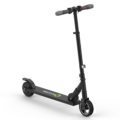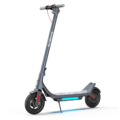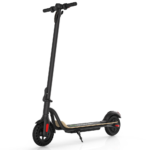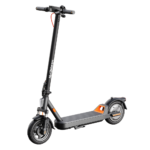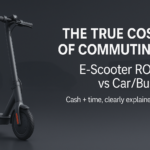- Home
- Scooters
- Electric Scooters
- MEGAWHEELS A1C
MEGAWHEELS A1C



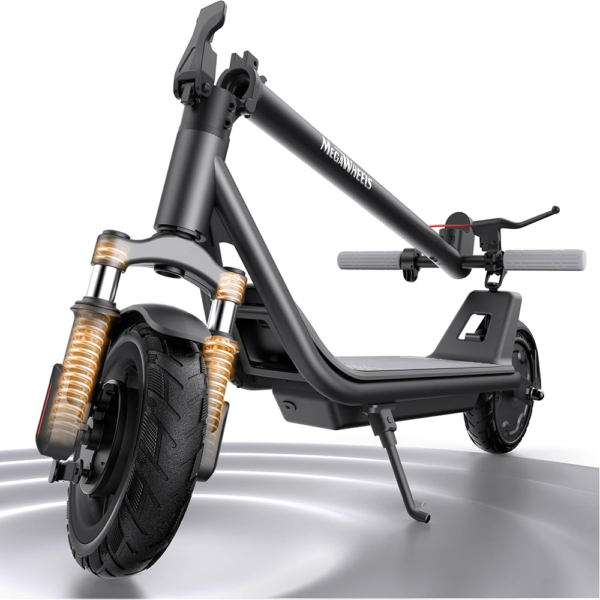
- Battery Range: ≈13 miles (21 km)
- Top Speed: 15.0 mph (25 km/h)
- Motor Power: 250 W
- Weight Capacity: 220 lb (100 kg)
- Charging Time: ≈5.5 h
- Scooter Weight: 32.9 lb (14.9 kg)
PROS
- Front suspension
- IPX5 water resistance
- LEQISMART app lock
- 8.5″ solid tires
- Auto lighting
CONS
- Modest 13-mile range
- 15 mph cap
- Drive wheel unspecified
Table of contents
- What Is the MEGAWHEELS A1C?
- How the MEGAWHEELS A1C Works
- Key Specifications
- Design & Build Quality
- Performance Fundamentals
- Battery, Range & Efficiency
- Ride Quality & Comfort
- Braking & Safety Features
- Portability & Daily Usability
- Maintenance & Care
- Weather & Seasonal Considerations
- MEGAWHEELS A1C vs Alternatives
- Who the MEGAWHEELS A1C Is (and Isn’t) For
- FAQs
- Glossary
- Final Notes on Source Data
If you want a simple, budget-friendly scooter that still feels thoughtfully engineered, the MEGAWHEELS A1C lands in a sweet spot. It focuses on the basics that matter for short, predictable trips: easy controls, sensible safety features, and a compact fold. Because it keeps power modest and components straightforward, it suits newer riders, students, and last-mile commuters who value practicality over flash.
The MEGAWHEELS A1C is built for flat, paved routes and routine errands. It will not win drag races; however, it does win on low drama and low upkeep. If “charge, ride, fold, repeat” is your rhythm, this scooter fits right in.
What Is the MEGAWHEELS A1C?
The MEGAWHEELS A1C is a compact, front-motor electric scooter with 8.5-inch solid tires, front twin-tube suspension, and a simple cockpit anchored by a single multifunction button and a clear display. It runs a 250-watt hub motor on a 6-cell battery pack (21.9 V nominal, 7.5 Ah), which keeps weight down and range predictable. You get three speed modes that cap top speed at roughly 15 mph (25 km/h). The scooter is rated for riders up to 220 lb (100 kg) and folds quickly to store under a desk or in a hallway.
Instead of stacking on power, the A1C leans on everyday usability: automatic front and rear lights via a photosensor, Bluetooth connectivity through the LEQISMART app for lock/unlock and basic settings, and a rear mechanical brake for direct, familiar stopping. It’s designed as a city sidewalk and bike-lane companion, not an off-road toy.
How the MEGAWHEELS A1C Works
Think of the A1C as a compact, electric “push-assist” board with a brain:
- Motor: A front hub motor rated at 250 W provides gentle, linear thrust. Because it lives in the wheel, power goes straight to the ground with no chains or belts. That keeps noise low and maintenance simpler.
- Controller: A sealed controller regulates power delivery. It reads your throttle input and meters current so the motor accelerates smoothly rather than jerking. It also limits top speed in each mode.
- Battery: A 21.9 V, 7.5 Ah lithium-ion pack stores about 164 Wh of energy—enough for short daily trips. The battery includes a protection system that monitors temperature, current, and voltage.
- Throttle: A thumb-actuated accelerator tells the controller how much power to send. Hold it steady, and the scooter settles into a stable cruise in the selected mode.
- Brakes: A rear drum brake engages with a lever at the bar, delivering consistent, weather-resistant braking. It gives a predictable bite and avoids the squeal that some rim systems develop.
- Lights & Display: A compact display shows speed and battery bars. A photosensor can switch lights on automatically when you roll from bright areas into darker ones.
Because each piece is small and integrated, the scooter feels quiet and tidy—closer to an appliance than a hobby project.
Key Specifications
Below are the headline specs organized into logical blocks so you can scan what matters most. Values include both units where useful.
| Block | Item | Value |
|---|---|---|
| General | Model | MEGAWHEELS A1C |
| Rider age (guidance) | 12+ | |
| Max rider load | 220 lb (100 kg) | |
| Performance & Power | Motor | 250 W front hub |
| Top speed (High mode) | ~15 mph (25 km/h) | |
| Climbing ability | ~10% grade (short hills, rider and conditions dependent) | |
| Battery, Charging & Electrical | Battery | 21.9 V, 7.5 Ah (≈ 164 Wh) |
| Max charge voltage | 25.2 V | |
| Charger output | 24.2 V, 1.5 A (≈ 36 W) | |
| Typical charge time | ~5.5 hours | |
| BMS protections | Over-heat, short-circuit, over-current, over-discharge, over-charge | |
| App | LEQISMART (Bluetooth lock/unlock, basic settings) | |
| Build & Dimensions | Tires | 8.5 × 2-in solid (front & rear) |
| Suspension | Front twin-tube, ~25 mm travel (light) | |
| Dimensions (assembled) | 43.03 × 17.32 × 45.08 in (109.3 × 44.0 × 114.5 cm) | |
| Dimensions (folded) | 43.03 × 17.32 × 20.51 in (109.3 × 44.0 × 52.1 cm) | |
| Net weight | 32.85 lb (≈ 14.9 kg) | |
| Safety & Control | Brakes | Rear mechanical drum with bar-mounted lever |
| Lighting | Headlight and tail light; auto on/off via photosensor | |
| IP rating | IPX5 (splash resistant) | |
| Features & Extras | Speed modes | L (~3 mph / 5 km/h), M (~9 mph / 15 km/h), H (~15 mph / 25 km/h) |
| App lock/alarm | Bluetooth lock with parking indicator; movement triggers tail-light alarm | |
| Unit toggle | Switch mph/km/h from the power button | |
| Cruise Control | Not specified in the official manual; some retailer listings mention it—availability may vary by firmware/region. | |
| Warranty & Compliance | Limited warranty | Commonly listed as 1-year limited coverage (region/seller dependent) |
| Compliance notes | Listings associate the model with UL-style safety labeling and regional approvals; labeling on your retail box/manual applies. |
Notes on the table: Values above reflect the manufacturer’s manual and official product descriptions; minor variations can exist by region or batch. Always confirm your unit’s label and quick-start card.
Design & Build Quality
The A1C’s frame sits low and looks clean. Because the motor lives in the front wheel, the rear assembly can house a compact drum brake under the fender—which stays largely sealed from weather. The deck uses a grippy top surface with a subtle kicktail to help your rear foot lock in. The cockpit keeps clutter to a minimum: a single button handles power, lights, and mode changes, while the thumb throttle and brake lever fall naturally under your hands.
Fit-and-finish is what you expect at this price, yet it still feels intentional. Panel gaps are narrow, wiring routes are tucked, and the folding latch closes with a distinct “click.” The front twin-tube suspension is modest in travel, but it helps tame buzz from rough pavement and tile seams. Because the tires are solid, that added compliance matters. You won’t confuse it with long-travel shocks, however the fork remains a welcome touch on a budget platform.
Overall stiffness is decent for short hops. There’s mild stem flex if you hit repeated joints at speed, yet it stays controllable. The wide, flat deck gives enough stance width for average shoe sizes without pushing your feet into awkward angles.
Performance Fundamentals
Acceleration feel. In Low and Mid modes, the scooter steps away gently. That’s ideal for crowded spaces and new riders. In High mode, it still accelerates with restraint. The throttle tune favors smoothness over snap, which reduces wheel slip on painted lines and wet patches. Because power is capped at 250 W, launches never feel abrupt.
Cruising stability. The A1C cruises most comfortably between 10 and 14 mph (16–23 km/h). At that pace, the steering stays light and predictable. The solid tires can hum on concrete, yet they track straight. The front suspension reduces hand buzz, so palms fatigue less on longer straight runs.
Hill-climb behavior. Short neighborhood grades in the 7–10% range are manageable if you enter with a little momentum. Speed will drop as grade and rider mass increase, which is normal for a compact commuter motor. Expect to help with a kick if a hill turns steep and long. On flat routes, the power ceiling feels well matched to the scooter’s intent.
Battery, Range & Efficiency
The A1C’s 21.9 V, 7.5 Ah pack stores about 164 Wh. That size keeps weight down and charge times reasonable. In a controlled scenario—steady 9 mph (15 km/h), 165 lb (75 kg) rider, mild weather—the scooter claims around 13 miles (≈ 21 km) per charge. In the real world, range depends on:
- Speed: Riding closer to 15 mph (25 km/h) draws more power than cruising at 10–12 mph (16–19 km/h).
- Rider mass & cargo: Heavier loads increase current draw.
- Terrain & surfaces: Rolling hills and coarse pavement consume more energy.
- Temperature: Cold batteries can’t deliver or accept charge as efficiently.
- Tire hardness & pressure equivalent: Solid tires remove tube maintenance but transmit more vibration, which can nudge consumption upward on rougher paths.
For many riders, a practical, mixed-pace range lands near 7–11 miles (11–18 km) per charge. Plan your return or add a top-off at work if you need more.
Charging best practices. Use the included 24.2 V, 1.5 A charger. Because the pack is small, topping off is easy—plug in during lunch or after your commute. Store the scooter around room temperature and, if shelving for weeks, leave the battery near 60–70%. Charge fully every few months during long storage. These habits preserve cycle life and keep the pack balanced.
Ride Quality & Comfort
Solid 8.5-inch tires mean no flats and no air checks, which simplifies ownership. They also ride firmer than inflated rubber. That’s where the A1C’s front twin-tube suspension earns its keep. It won’t erase potholes; instead, it softens rapid, high-frequency chatter from expansion joints, pavers, and brick. Hands feel less tingly after a few miles, and the fork helps the front wheel stay in contact with the ground over small ripples.
The deck stands low, so you step on and off easily at crossings. The bar height suits average adults and teens; taller riders can angle elbows slightly to stay relaxed. There is some stem flex if you lean hard on the bar over rough surfaces, yet it settles quickly. Because the scooter is light, you can weave around obstacles or dismount and walk without strain.
Braking & Safety Features
The rear mechanical drum brake provides steady deceleration with little maintenance. It resists water better than rim brakes and avoids alignment fuss common to calipers. Pull the lever halfway, and you feel mild bite; pull further, and the drum firms up for a controlled stop. Practice on an empty stretch to learn the lever’s sweet spot. Keep both hands on the bar when braking, and shift a bit of weight back to stabilize the deck.
Lighting matters on smaller scooters, and the A1C handles this nicely. A photosensor can switch the headlight and tail light on automatically as ambient light drops. You can also toggle lights manually with a short press. The tail light flashes rapidly if the scooter moves while locked through the app, which doubles as a visual theft deterrent. Reflective accents on your helmet or jacket still help you stand out, especially at dusk.
The IPX5 splash rating covers riding through light spray and shallow splashes. It doesn’t mean submersion, pressure washing, or heavy rain. Avoid deep puddles and rinse-like hose streams. Wipe the deck and contact points dry after wet rides, and store the scooter in a ventilated, covered place.
Portability & Daily Usability
At 32.85 lb (≈ 14.9 kg), the A1C is light enough for a single flight of stairs, short train platforms, or a dorm elevator. The fold is straightforward: flip the latch, lower the stem, and hook it for carry. The folded package measures 43.03 × 17.32 × 20.51 in (109.3 × 44.0 × 52.1 cm), which fits under many desks and in most car trunks.
Because the tires are solid, you can park without worrying about slow leaks. The app-based lock is helpful for quick café stops, although a small frame lock remains wise if you’ll leave the scooter out of sight. Carry a cloth for the deck if your commute includes puddles; a quick wipe keeps floors clean when you bring it indoors.
Maintenance & Care
A simple scooter thrives on simple habits. Use this light-duty schedule as a starting point:
- Every ride: Check that the latch closes fully and the bell/clip holds the stem securely when folded. Confirm the brake lever feels firm and the display shows enough battery bars for your route.
- Weekly: Inspect fasteners around the stem clamp, handlebar, and brake linkage. Tighten gently if anything loosens; avoid overtightening. Wipe dust and grit from the deck and fork.
- Monthly: Check rear brake engagement. If lever throw grows long, adjust the cable at the brake arm or lever to restore a firm bite. Inspect drum housing and rear fender for rub.
- Quarterly: Inspect the front suspension tubes for grime buildup. Clean and dry the area; avoid spraying water into the mechanism.
- Battery care: Keep the pack between 20–80% for day-to-day use when convenient. Top to 100% just before longer rides. During long storage, recharge fully every few months.
Firmware updates and app features may change over time. Open the app occasionally to check for updates and to review settings.
Weather & Seasonal Considerations
Rain. Because the A1C is rated IPX5, it handles light spray and road mist, yet you should still ride conservatively. Painted lines, metal grates, and wet leaves get slick fast on solid tires. Brake earlier than usual and keep speed in the Mid mode if conditions worsen. Dry the deck and charge port area after you get inside.
Heat. Lithium-ion batteries prefer moderate temperatures. On hot days, give the scooter a few minutes to cool before charging. Avoid storing in a parked car under direct sun.
Cold. Expect reduced range when temperatures drop. If you can, store the scooter indoors and head out with a warm battery. Start in Low or Mid mode until your hands and tires “settle in,” then bump up speed if conditions allow.
MEGAWHEELS A1C vs Alternatives
Within the urban “budget commuter” class, scooters cluster into three camps:
- Ultra-light last-mile (under ~28 lb / 13 kg). These prioritize featherweight carry at the cost of stability and deck space. The A1C is heavier but more planted, and it adds a drum brake and small suspension—important quality-of-life upgrades for rough sidewalks.
- Balanced budget commuters (~30–38 lb / 14–17 kg). The A1C sits here. It offers modest power and a predictable top speed. It suits flat routes, school campuses, and short city hops where reliability and value matter most.
- High-torque commuters (two-motor or ≥ 500 W single). These climb better and surge quicker, yet they cost and weigh more. If you face frequent 10% hills or need 20+ mile range, that tier fits better. Otherwise, the A1C wins on simplicity, ease of storage, and lower upkeep.
For riders exploring a step-up alternative from this class, consider the MEGAWHEELS A6L Eco. It keeps everyday usability in focus while offering a different take on the brand’s commuter formula.
Where does the A1C excel? On straightforward urban errands, mixed transit commutes, and short rides where a tidy fold and no-flat tires beat raw power. Where does it struggle? On long, hilly routes or bumpy back lanes that demand large pneumatic tires and robust suspension.
Who the MEGAWHEELS A1C Is (and Isn’t) For
Great for:
- Students and apartment dwellers who value a compact fold.
- New riders who want smooth, capped speed and easy handling.
- Multi-modal commuters who carry a scooter onto trains or buses.
- Errand runners who prefer low-maintenance solid tires.
Not ideal for:
- Riders tackling daily steeps above ~10% or extended hill climbs.
- Long-range commuters who need 15–20 miles each way.
- Off-road curious riders who plan to leave pavement often.
If you ride mostly level paths, want predictable controls, and appreciate simple ownership, the A1C checks a lot of boxes without draining the budget.
FAQs
1) How fast does it go?
In High mode, the A1C tops out around 15 mph (25 km/h). That limit helps keep handling calm on crowded city paths.
2) What real-world range should I expect?
Plan on 7–11 miles (11–18 km) per charge at mixed speeds with an average-weight rider on mostly flat ground.
3) Can I ride it in the rain?
It carries an IPX5 splash rating. Light spray and damp pavement are fine with caution. Avoid heavy rain, deep puddles, and high-pressure water.
4) Does it have cruise control?
The official manual doesn’t spell it out. Some retailer listings mention a cruise feature through the app, so availability may vary by firmware and region. Treat it as optional, not guaranteed.
5) What about hills?
Short grades around 7–10% are manageable, especially with a rolling start. On longer or steeper climbs, speed will drop; a helpful kick may be needed.
6) What makes the MEGAWHEELS A1C overview different from sportier scooters?
It emphasizes simplicity: capped speed, solid tires, front suspension for buzz control, and a compact fold. It’s meant for reliable short trips rather than power riding.
7) How do the lights work?
A photosensor can turn the headlight and tail light on automatically as light fades. You can also toggle them manually with the power button.
Glossary
- Ah (Amp-hour): Battery capacity measure; higher Ah means more stored charge.
- Wh (Watt-hour): Battery energy measure; Wh ≈ voltage × Ah; most useful for comparing range potential.
- BMS (Battery Management System): Electronics that protect the pack from over-charge, over-discharge, and other faults.
- Controller: The scooter’s “brain” that meters current to the motor based on throttle input and mode settings.
- Hub Motor: An electric motor built into the wheel hub; quiet and low-maintenance.
- Drum Brake: A sealed brake where shoes press outward against a drum; consistent in wet conditions.
- Regen: Regenerative braking that converts motion into a small amount of charge. (Not specified for A1C.)
- Stem Flex: The slight bending you feel at the handlebar over bumps; common on lighter scooters.
- IP Rating: Ingress Protection; IPX5 means resistant to water spray from any direction, not immersion.
- Puncture-proof Tire: A solid or honeycomb tire that won’t go flat; rides firmer than air.
- Grade: The steepness of a hill; 10% grade rises 10 m over 100 m horizontally.
- Speed Modes: Software limits that cap maximum speed and tune acceleration.
- Photosensor: A light sensor that can trigger automatic headlight/tail light behavior.
- LEQISMART App: Companion app for Bluetooth lock/unlock and basic settings on supported models.
- UL-style Certification: Safety standard labeling typically related to electrical components; always check your unit’s actual marking.
Final Notes on Source Data
This article consolidates values from the official A1C user manual and the manufacturer’s product description. Warranty and some listing details may vary by region and seller; always confirm on your unit’s label and documentation.
Specifications
General
| Model The Model specifies the exact version or name of the scooter. It helps identify its unique design, features, and specifications within the manufacturer’s product line. Knowing the model makes it easier to compare options, find compatible accessories, or look up support information. | A1C |
| Brand The Brand identifies the manufacturer or company that designs and produces the scooter. A trusted brand is a sign of quality, reliability, and good customer support. Well-known brands often have higher standards for safety, performance, and after-sales service, giving you more confidence in your purchase. | MEGAWHEELS |
| Release Date The Release Date indicates when the scooter model was officially launched on the market. This helps you know how current the design, technology, and features are. A newer release date often means updated components, improved performance, and the latest safety or smart features. | 17 November 2025 |
| Recommended Age Recommended Age indicates the minimum age range that the scooter is designed for, based on safety, size, and ease of use. Following the recommended age helps ensure that riders can handle the scooter’s speed, weight, and controls comfortably and safely. Always check local laws and use protective gear, especially for younger riders. | 12+ |
Performance & Power
| Motor Power (Wattage) What it means: The motor power, measured in watts (W), shows how strong the scooter’s electric motor is. Why it matters: Higher wattage usually means better acceleration, more torque, and improved performance on hills or rough terrain. For example, a 250W motor is good for flat city roads and light riders, while a 500W or 1000W motor provides more power for faster speeds or climbing steep inclines. | 250 W wheel motor (rated) |
| Top Speed The Top Speed indicates the maximum speed that the scooter can reach under optimal conditions. It’s usually measured on level ground with a fully charged battery and an average rider weight. A higher top speed allows you to travel longer distances faster, but always ensure you ride within legal speed limits and your personal comfort zone for safety. | 15.0 mph (25 km/h) |
| Battery Capacity Battery Capacity refers to the total amount of energy the scooter’s battery can store, usually measured in ampere-hours (Ah) or watt-hours (Wh). A higher battery capacity means you can ride longer distances on a single charge, reducing the need for frequent recharging. Keep in mind that actual range can vary depending on rider weight, terrain, speed, and weather conditions. | 21.9 V 7.5 Ah (164 Wh) |
| Estimated Range per Charge The Estimated Range per Charge indicates the average distance the scooter can travel on a single full battery charge. This range is calculated under optimal conditions, such as flat terrain, moderate speed, and average rider weight. Real-world range may vary depending on riding style, terrain, weather, and load. A longer range means fewer recharges and greater freedom for longer trips. | Up to ~13 miles (21 km) |
| Hill Climb Ability Hill Climb Ability describes the maximum incline or slope that the scooter can handle while maintaining stable performance. It’s typically expressed as a percentage or in degrees. A higher hill climb rating means the scooter can tackle steeper hills without losing too much speed or power. Actual climbing performance may vary based on rider weight, battery charge, and terrain conditions. | Up to 10% |
| Drive System The Drive System refers to how power from the motor is delivered to the wheels. Electric scooters typically use either a hub motor (directly integrated into the wheel) or a chain/belt drive system. A high-quality drive system ensures smooth acceleration, efficient power transfer, and low maintenance. The choice of drive system affects performance, noise level, and overall ride experience. | Not specified |
Charging & Electrical
| Charging Time Charging Time indicates how long it takes to fully recharge the scooter’s battery from empty to 100% using the standard charger provided. Faster charging means less downtime and more time on the road. Actual charging time may vary slightly depending on battery capacity, charger output, and environmental conditions. | Approx. 5.5 hours |
| Battery Type Battery Type refers to the specific technology used in the scooter’s battery, which affects performance, lifespan, weight, and charging time. Most modern electric scooters use high-quality lithium-ion (Li-ion) batteries because they offer a good balance of energy density, durability, and low maintenance. A reliable battery type ensures consistent power delivery and longer riding ranges. | Lithium-ion with Smart BMS |
| Removable Battery A Removable Battery means the battery pack can be easily detached from the scooter for convenient charging and replacement. This feature allows you to charge the battery separately, swap it with a spare for extended range, or securely store it indoors in extreme weather. Removable batteries add flexibility and make it easier to keep your scooter powered up wherever you are. | Non-removable internal battery |
| Regenerative Braking Regenerative Braking is an energy-saving feature that converts some of the energy normally lost during braking back into battery power. When you slow down or brake, the motor works in reverse to generate electricity, which helps extend the scooter’s range and improves overall efficiency. This system also reduces wear on traditional brake components, leading to lower maintenance over time. | Not specified |
| Lighting Lighting refers to the built-in front and rear lights that enhance visibility and safety when riding in low-light conditions or at night. Good lighting helps you see the road ahead and ensures that other road users can see you. Many scooters include LED headlights, taillights, and sometimes brake lights or side reflectors for added safety and compliance with local traffic regulations. | Auto LED headlight + rear LED; ambient light sensor |
Build & Dimensions
| Scooter Weight Scooter Weight refers to the total weight of the scooter when fully assembled, including the battery. This affects how easy it is to carry, lift, and store the scooter when not in use. A lighter scooter is more portable and convenient for commuting, especially if you need to carry it upstairs or onto public transport. Keep in mind that a sturdy frame and quality components may add to the weight but also contribute to better durability and ride stability. | 32.9 lb (14.9 kg) |
| Maximum Rider Weight Maximum Rider Weight indicates the highest rider weight that the scooter is designed to safely support while maintaining optimal performance and stability. Staying within this limit helps ensure reliable acceleration, braking, and climbing ability, and it protects the frame, suspension, and motor from excessive strain. Exceeding the recommended limit may reduce performance and increase wear on components. | 220 lb (100 kg) |
| Deck Size Deck Size refers to the dimensions of the scooter’s standing platform. A wider and longer deck provides more foot space, allowing you to stand comfortably and adjust your stance while riding. A well-sized deck improves balance and stability, especially on longer rides or at higher speeds. Compact decks, on the other hand, help keep the scooter lightweight and portable. | Front twin-tube shock; solid 8.5″ tires |
| Handlebar Height Handlebar Height refers to the distance from the deck to the handlebars, which affects your riding posture and comfort. An appropriate handlebar height helps you maintain good balance, reduces strain on your back and arms, and makes steering more comfortable. Some scooters have adjustable handlebars to fit riders of different heights, while others have a fixed height for a streamlined design. | Fixed; ~45.1 in height |
| Folding Mechanism The Folding Mechanism describes how easily and securely the scooter can be folded for carrying and storage. A well-designed folding system lets you quickly collapse the scooter into a compact size, making it convenient to transport on public transit, store under a desk, or fit into a car trunk. Look for sturdy latches and safety locks to ensure the scooter stays firmly in place when folded or unfolded. | Lever folding with hook latch |
| Dimensions Folded Dimensions indicate the size of the scooter when it’s fully folded. This measurement shows how much space the scooter will take up when stored or carried, making it easier to check if it will fit in your car trunk, under a desk, or in a closet. Compact folded dimensions are ideal for commuters who need to bring their scooter on public transport or store it in tight spaces. | Unfolded: 43.0 × 17.3 × 45.1 in (109.3 × 44.0 × 114.5 cm); Folded: 43.0 × 17.3 × 20.5 in (109.3 × 44.0 × 52.1 cm) |
| Material Material refers to the primary construction materials used for the scooter’s frame and key components. High-quality materials like aircraft-grade aluminum, reinforced steel, or durable composites provide strength, stability, and a lighter overall weight. A sturdy material ensures the scooter can handle daily wear and tear while maintaining safety and performance. | Metal (unspecified alloy) |
Safety & Control
| Brake Type(s) Brake Type(s) describe the braking systems the scooter uses to help you slow down or stop safely. Common brake types include mechanical brakes (like drum or disc brakes), electronic brakes, and foot brakes. Many scooters combine multiple braking systems for added safety and shorter stopping distances. The type and quality of brakes affect your control, especially when riding at higher speeds or on slopes. | Electronic + mechanical brake (type not specified) |
| Suspension Suspension refers to the system that absorbs shocks and vibrations while riding, providing a smoother and more comfortable ride over uneven or rough surfaces. Scooters may have front suspension, rear suspension, or dual suspension for better shock absorption and stability. Good suspension helps reduce rider fatigue and improves control, especially when riding on bumpy roads or off-road paths. | Front suspension |
| Tire Type Tire Type refers to the kind of tires the scooter uses, which directly affects ride comfort, traction, and maintenance. Common types include solid (airless) tires, pneumatic (air-filled) tires, or hybrid options. Pneumatic tires offer better shock absorption and a smoother ride on rough surfaces, while solid tires are puncture-proof and require less upkeep. The right tire type helps ensure safe handling and a comfortable ride in different conditions. | 8.5″ solid tires |
| Tire Size Tire Size indicates the diameter and width of the scooter’s tires, which affect ride comfort, stability, and how well the scooter handles different terrains. Larger tires generally offer better shock absorption and a smoother ride over bumps and rough surfaces, while smaller tires keep the scooter lighter and more portable. Choosing the right tire size helps ensure a balance between agility and comfort. | 8.5-inch |
| Kickstand The Kickstand is a built-in stand that allows you to park your scooter upright when it’s not in use. A sturdy kickstand keeps the scooter stable and prevents it from tipping over, protecting it from scratches and damage. It also makes storing and accessing your scooter more convenient, whether you’re at home, work, or on the go. | Not specified |
| Water Resistance Rating Water Resistance Rating indicates how well the scooter is protected against water and moisture, usually shown as an IP (Ingress Protection) rating. This rating helps you understand whether the scooter can handle light rain, splashes, or wet roads without damage. While most scooters are not fully waterproof, a good water resistance rating adds peace of mind when riding in changing weather conditions. Always avoid deep puddles or submerging the scooter to protect its electrical components. | IPX5 |
Features & Extras
| Display/Console The Display (or Console) shows important real-time information about your ride, helping you monitor your scooter’s status at a glance. Typical displays show speed, battery level, distance traveled, and riding mode. Some models also include additional features like Bluetooth connectivity, app integration, or backlighting for better visibility at night. A clear and easy-to-read display enhances safety and convenience on every trip. | Digital display (speed, battery, modes, Bluetooth) |
| Ride Modes Ride Modes refer to the different speed and power settings you can choose to match your riding style or road conditions. Common modes include eco for maximum range and energy efficiency, standard for everyday balance, and sport or turbo for higher speed and stronger acceleration. Switching between ride modes allows you to customize performance, conserve battery, and ride safely in various environments. | L/M/H (3 modes) |
| Smart App Connectivity Smart App Connectivity lets you pair your scooter with a dedicated mobile app via Bluetooth. Using the app, you can monitor real-time ride stats like speed, battery level, and range, adjust settings such as ride modes or cruise control, lock the scooter for added security, and sometimes receive firmware updates. This feature adds convenience and allows you to personalize your riding experience right from your smartphone. | LEQISMART app (lock/unlock, alarm, metrics, unit switch) |
| Anti-Theft System The Anti-Theft System helps protect your scooter from unauthorized use or theft. This feature can include built-in alarms, electronic motor locks, GPS tracking, or remote locking through a mobile app. A good anti-theft system provides peace of mind when parking your scooter in public spaces, adding an extra layer of security to safeguard your investment. | App lock with alarm (Bluetooth) |
| Cruise Control Cruise Control allows you to maintain a steady speed without continuously holding the throttle. This feature makes longer rides more comfortable by reducing hand fatigue and providing a smoother, more relaxed riding experience — especially on flat, open roads or bike lanes. For safety, cruise control can usually be easily activated or deactivated while riding. | Not specified |
| Accessories Included Accessories Included lists the additional items that come with the scooter to enhance your riding experience and convenience. Common accessories may include a charger, kickstand, bell, lights, phone holder, or carrying strap. These extras add value by making your scooter safer, easier to use, and ready to ride straight out of the box. | Scooter, charger (24.2 V/1.5 A), tools, manual |
Warranty & Compliance
| Warranty Period The Warranty Period indicates how long the manufacturer guarantees the scooter against defects in materials and workmanship under normal use. A good warranty provides peace of mind, showing the brand’s confidence in its product quality. Always check what parts are covered, such as the frame, battery, and motor, and follow the maintenance guidelines to keep your warranty valid. | Region-dependent |
| Certifications Certifications confirm that the scooter meets specific safety, quality, and environmental standards set by recognized organizations or regulatory bodies. Common certifications may include CE, RoHS, UL, or other local compliance marks, depending on your region. These certifications ensure that the scooter is manufactured to high standards and is safe and legal to use in your country. | Local micromobility compliance |



